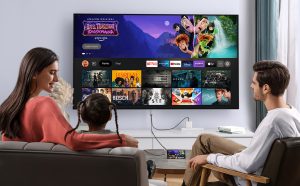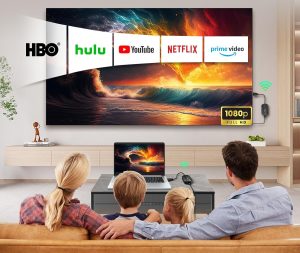Introduction
Streaming services have revolutionized the way we consume entertainment. From watching movies and TV shows to listening to music, these platforms offer convenience, variety, and personalized experiences. This transformation has disrupted traditional media, shaping a new era of entertainment for creators and audiences alike.
The Rise of Streaming Services

Streaming services like Netflix, Spotify, Disney+, and Amazon Prime Video have grown rapidly in recent years. With affordable subscription plans, these platforms make content accessible to millions worldwide. Unlike traditional media, streaming allows users to watch or listen on demand, eliminating the need to adhere to fixed schedules.
Key Factors Driving Growth
- Affordability: Lower costs compared to cable subscriptions.
- Convenience: On-demand access on multiple devices.
- Personalization: Advanced algorithms recommend content tailored to individual preferences.
The Growth of Streaming Platforms

Streaming platforms have quickly grown in popularity over the past few years. People are choosing streaming services more than traditional cable or satellite TV because they offer flexible, on-demand content. Services like Netflix, Hulu, and YouTube have millions of subscribers worldwide. This growth is driven by the fact that streaming is cheaper, easier to access, and provides more options than traditional TV. Viewers can watch content on their smartphones, tablets, and even gaming consoles, making it easier to enjoy entertainment wherever they are.
Impact on the Entertainment Industry

Streaming services have had a big impact on traditional TV. More people are choosing to cut the cord and stop paying for cable or satellite TV. This has caused TV networks to rethink how they deliver content. Some networks have started their own streaming platforms to keep up with the trend. For example, Disney launched Disney+ to offer content from Disney, Marvel, and Star Wars. With more people switching to streaming, traditional TV networks are facing a decline in viewership and advertising revenue.
1. Disruption of Traditional TV and Cinema
Streaming services have challenged traditional TV networks and movie theaters. Audiences now prefer the flexibility of watching content at home rather than following rigid schedules or going out to cinemas.
2. New Opportunities for Content Creators
Independent filmmakers, musicians, and smaller production houses can now reach global audiences through streaming platforms. This democratization of content has reduced reliance on large studios and labels.
3. Rise of Original Content
Platforms like Netflix and Amazon Prime have invested heavily in original programming. Series like Stranger Things and The Boys highlight how streaming services create exclusive, high-quality content to attract and retain subscribers.
4. Globalization of Entertainment
Streaming services have broken cultural and linguistic barriers by promoting international content. Hits like Squid Game and Money Heist have gained worldwide popularity, showcasing stories from non-English-speaking countries.
The Shift to Binge-Watching
Streaming services have changed the way people watch TV shows. In the past, viewers had to wait for a new episode of their favorite show each week. Now, many streaming platforms release entire seasons of shows at once, allowing viewers to binge-watch all the episodes in one sitting. This has led to a shift in how we consume TV, with many people choosing to watch multiple episodes in a row, making the experience feel more like a movie marathon than a traditional TV series.
Streaming and the End of Advertisements

One of the main differences between traditional TV and streaming services is the presence of ads. On traditional TV, viewers are often interrupted by commercials while watching shows or movies. However, many streaming platforms offer ad-free experiences for subscribers. This means that viewers can enjoy their content without being interrupted, making for a smoother and more enjoyable experience. Some platforms offer both ad-free and ad-supported options, giving users the choice to pay less or enjoy an ad-free experience.
Streaming and Family Entertainment
Streaming services are also changing how families watch TV together. With many different types of content available for all age groups, streaming platforms provide options for kids, teens, and adults. Platforms like Netflix and Disney+ offer a wide variety of family-friendly movies and shows that parents can feel good about watching with their children. This has made it easier for families to find content that suits everyone, all in one place.
Streaming and Independent Films
In the past, independent films often had trouble reaching a wide audience. Now, with the rise of streaming services, independent filmmakers have more opportunities to showcase their work to a global audience. Platforms like Amazon Prime Video and Netflix often feature independent films, allowing smaller productions to be seen alongside big-budget Hollywood blockbusters. This has helped many filmmakers gain recognition and success, even if they don’t have the backing of major studios.
The Environmental Impact of Streaming

While streaming services offer many benefits, they also have an environmental impact. The energy required to run the servers that store and stream content can contribute to carbon emissions. As streaming continues to grow, it’s important for companies to find ways to reduce their environmental footprint. Some streaming platforms are beginning to invest in renewable energy and more efficient technologies to reduce their impact. However, as more people use streaming services, it’s important to be mindful of how these platforms affect the environment.
The Need for Better Internet Access
Although streaming services are growing rapidly, they rely heavily on good internet access. People in rural areas or regions with limited internet options may struggle to enjoy streaming content at the same quality as those in cities with fast, reliable connections. As streaming services continue to grow, there is a need for better internet infrastructure worldwide. Improving access to high-speed internet will help more people enjoy streaming services, making them available to a wider audience.
Streaming Services and Personalization

One of the best features of streaming services is how they personalize the experience for each viewer. Platforms like Netflix and Spotify use algorithms to recommend movies, shows, and music based on what you’ve watched or listened to before. This means users can easily discover new content that matches their tastes. Personalized recommendations make it easier for people to find things they’ll enjoy without having to spend time searching through endless options.
The Role of Streaming in Music and Podcasts
Streaming services are not just for movies and TV shows they are also changing the music and podcast industries. Platforms like Spotify and Apple Music have made it easier for people to listen to their favorite songs anytime, without having to buy individual albums. In addition, podcast streaming has exploded in popularity. People can now listen to a wide range of topics, from comedy to true crime, at their convenience. The rise of music and podcast streaming has transformed how people discover and enjoy audio content.
Streaming Services and Global Access

One of the biggest advantages of streaming services is the ability to access content from all over the world. Shows and movies that were once only available in certain countries can now be watched by anyone with a subscription. This has led to a cultural exchange, where international films and TV shows become popular in regions outside of their home country. For example, the Korean drama Squid Game became a global hit after being released on Netflix, showing how streaming services can break down cultural and language barriers.
Challenges in the Streaming Era
Despite the many benefits, streaming services also face some challenges. One of the biggest problems is the overwhelming amount of content available. With so many options, it can be difficult to decide what to watch. Another challenge is the rising cost of subscriptions. As platforms add new features and content, they often increase their fees, which can be a burden for users. Finally, the competition between streaming services is fierce, with many platforms offering similar content, making it hard to stand out.
1. Content Overload
With too many options, viewers may feel overwhelmed. It has become harder for smaller titles to gain visibility.
2. Rising Subscription Costs
As streaming platforms increase their subscription fees, affordability may become a concern for some users.
3. Competition Among Platforms
The market is now crowded, with multiple platforms vying for user attention. This intense competition could lead to subscription fatigue.
The Future of Streaming Services

The future of streaming services looks bright, but it will require adaptation. As more people rely on these platforms for entertainment, services will need to find ways to keep users engaged. This could involve offering new and innovative content, improving user experience, or finding ways to reduce subscription costs. With technology continuing to advance, streaming services are likely to evolve further, offering even more personalized and interactive experiences for users.
Analysis Table: The Shift from Traditional to Streaming Services
| Aspect | Traditional TV | Streaming Services |
|---|---|---|
| Content Accessibility | Fixed schedule, limited access | On-demand, global access |
| Viewing Devices | TV sets, cable boxes | Smart devices (phones, tablets, TVs) |
| Content Delivery | Cable/satellite providers | Internet streaming |
| Consumer Control | Limited control over what to watch | High control over viewing preferences |
| Audience Engagement | Passive viewing, ads frequent | Binge-watching, personalized recommendations |
| Cost Model | Subscription + ads or pay-per-view | Subscription-based or ad-supported |
| Global Reach | Regional channels | Global distribution with subtitles and dubbing |
Comparative Table: Streaming Services vs. Traditional Media
| Factor | Streaming Services | Traditional TV & Movie Theaters |
|---|---|---|
| Content Availability | Vast, including exclusive shows & films | Limited, often bound by schedules |
| Pricing Model | Subscription or ads-based | Pay-per-view, cable bundles |
| Accessibility | Instant access, mobile devices | Scheduled programming or theater visits |
| Content Variety | Huge variety, global options | Typically limited to regional content |
| Viewing Control | Choose content, when, and where | Fixed viewing time, scheduled content |
| Consumer Engagement | Personalized algorithms, binge-watching | Passive viewing, commercials interrupt |
| Revenue Model | Subscriptions, ads, partnerships | Advertisements, box office earnings, syndication |
Conclusion
The influence of streaming services on the entertainment industry has been profound. From shifting how content is produced and consumed to altering the financial landscape, streaming has reshaped the entertainment world in ways that were unimaginable just a few decades ago. With their global reach, accessibility, and personalized content, streaming platforms have redefined the relationship between creators and viewers, ensuring that the entertainment industry will continue to evolve in exciting and unpredictable ways.










